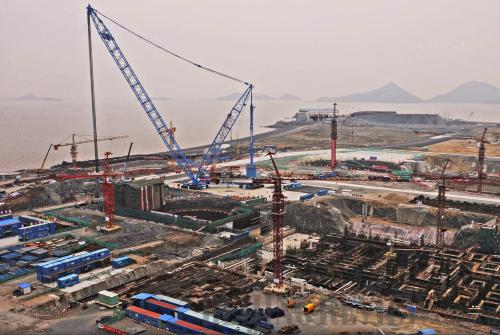|
 |
|
POWERING UP: China is making a push into new energy as part of its efforts to build sustainable power supplies. Construction on the first phase of the Zhejiang Sanman Nuclear Power Station is now progressing smoothly. The two generating units of the first phase each have a capacity of 1.25 gigawatts, and are scheduled to come into operation in 2013 and 2014 (TAN JIN) |
The main challenges for China going forward will be centered around re-orienting its production capacity toward the domestic economy and confronting the challenges that will arise as its population ages.
How long do you think it will take the developed economies to restart their economic engines, and why?
High-income countries as a group are currently experiencing mixed results. Most high-income countries face headwinds coming from the need to move fiscal policy back to a sustainable path, from high unemployment and excess capacity, and from the consolidation of their banking sectors. All of these factors can be expected to continue to weigh on growth. In the United States and Japan, despite these headwinds, growth seems to be moving toward a more broadly based footing, supported by self-sustaining expansions in investment and consumer demand and improving labor market conditions. In Europe, the situation is more difficult—growth which was initially quite strong in the third quarter of 2009 has been slowing, and domestic demand has not rebounded in the same way as it has in the United States.
Looking forward, the uncertainties associated with market concerns about the sustainability of fiscal policy in some countries and the more general need to reduce government deficits will weigh further on growth in Europe.
In the long term, challenges associated with aging populations (notably for Japan and Europe), will take center stage, and reforms for both the financial and real-side of economies required to adjust to this emerging environment will present substantial challenges for policymakers in high-income countries.
Should we be optimistic about the resolution of the European debt crisis by the EU itself or with IMF assistance?
 |
|
EXPORTS RECOVERING: Employees at a garment factory of the Qingdao Jifa Group, Shandong Province, work around the clock to fulfill export orders from Japan (LI ZHENG) |
The situation in Europe remains uncertain. It appears that ability of countries to meet their debt obligations over the next few years has been assured with the Euro-Area Financial Stability Pact. However, financial markets are still expressing concern about the willingness of some countries to implement the necessary cuts in spending and increase in taxes to put their finances onto a sustainable path over the longer term, and the credit ratings of several high-income countries have been marked down recently. Moreover, commercial and state-owned banks are coming under close attention for credit reevaluation, and a number have formed consortia which may lead to consolidation. While credit default swaps (the price of insurance against default) have risen for some countries, financial markets continue to see the likelihood of a default as low for most countries.
In part, this is because countries are taking necessary steps, sometimes in the face of substantial domestic opposition. Significant consolidation plans have been announced and are being put in place in many countries, which in conjunction with the Euro-Area Financial Stability Pact, suggests that it is unlikely there will be a serious deterioration of conditions.
To what extent could the European debt crisis stall the global economic recovery?
Recent developments in Europe are certainly a negative for growth in the coming quarters and partly because of associated uncertainties, the World Bank's most recent forecast in Global Economic Prospects presents a range of possible outcomes for the global economy. The baseline forecast assumes that the present financial difficulties in Europe are brought to resolution gradually and smoothly over the coming year, but recognizes that steps taken along the way to consolidate fiscal policy could slow growth, notably in Europe.
Effects of these measures on the rest of the world would flow through trade, because of very close European trade ties to developing countries in Europe and Central Asia, the Middle East and North Africa, and Sub-Saharan Africa. Should investors continue to remain nervous and begin to demand higher returns to compensate for an increase in perceived risk, this could slow growth further. | 